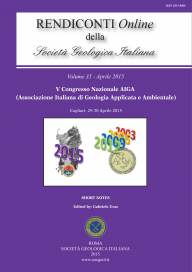
La tecnologia innovativa, senza dragaggi convenzionali, per la rimozione degli inquinanti dai sedimenti e il riutilizzo selettivo degli stessi dopo separazione granulometrica: Un caso in Sardegna
Giuliano Gabbani (a,b,d,e,f) & Davide Benedetti (b,c)
(a) Dipartimento di Scienze della Terra, Università di Firenze, via La Pira , 4, 50121 Firenze, Italy. e-mail: giuliano.gabbani@unifi.it
(b) G.I.G.A. (Gruppo Informale per la Geotermia e l'Ambiente) c/o Multiverso, via Campo d'Arrigo 42r, 50131 Firenze, Italy.
(c) Decomar S.p.A., via E. Mattioli 1, 56025 Pontedera, Italy.
(d) FREE, Coordinamento (Fonti Rinnovabili e Efficienza Energetica) – Roma.
(e) CIRPS, La Sapienza – Sezione di Firenze.
(f) IBIMET – CNR, Sezione di Sassari.
Volume: 35/2015
Pages: 152-154
Abstract
An innovative technology of sludging and separation of pollutants from sediments of varying grain size has been carried out in a basin in SW Sardinia.
The removal of sediment and materials accumulated in ports, docks and all areas, where the morphology favours these natural phenomena, is often a problematic operation mostly due to the environmental impact. Sludging is commonly performed mechanically with conventional dredging.
This work deals with the problematics and types of intervention of sludging and, in addition to the different regulations concerning this topic, offers a patented innovative solution. The sediments are removed doing a grain-size selection of the particles, and, most important, the polluted material and harmful substances are taken away without contaminating the surrounding environment.
This technology, now mature and well experienced, is also supportive to the nourishment of the coasts with a well-defined grain size material. This is a valuable response to the problems, often present in the existing nourishments, related to the natural remobilization of the new sandy material during the first sea storm which tends to bring the seabed back to the natural conditions prior to sludging.
Keywords
Erosion, Factors and processes of instability of the coast, Evolution and morphodynamics of the coastal and inshore seabed, Marine sediments, Risks and management of the coast, Sardinia.
Get Full Text